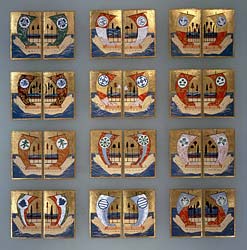It is not surprising, therefore, that playing cards spread like wildfire. Their origins remain a matter of dispute, but Asia or the Islamic world is the likely source. China remains the most probable place of origin, not only because the earliest indisputable reference to playing cards survives from China, but also because of its widespread use of paper and printing. China lays claim to the earliest use of woodblock printing in the seventh century, antedating by more than six centuries the appearance of religious prints and block-printed books in Europe in the early fourteenth century.
Although playing cards are the most familiar form of matching game, they are not the only type. Tile games such as mahjong and dominoes are closely related to playing cards, and the Japanese shell-matching game (kai-ooi) embodies the principle of matching like with like that is common to playing cards.






